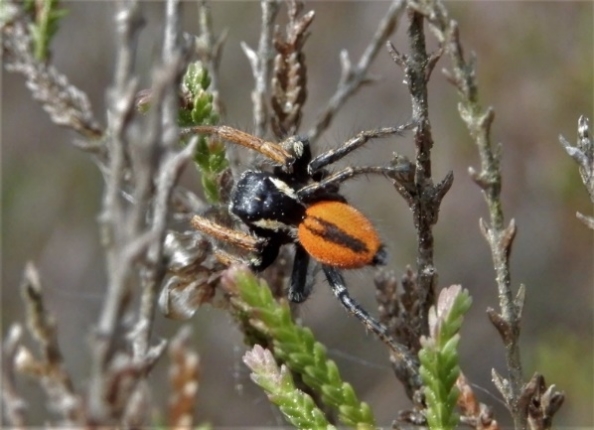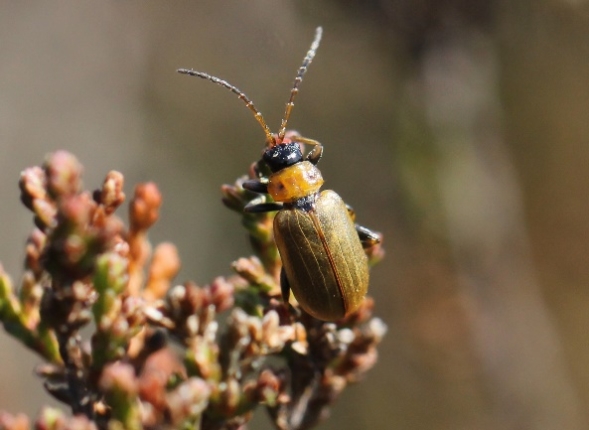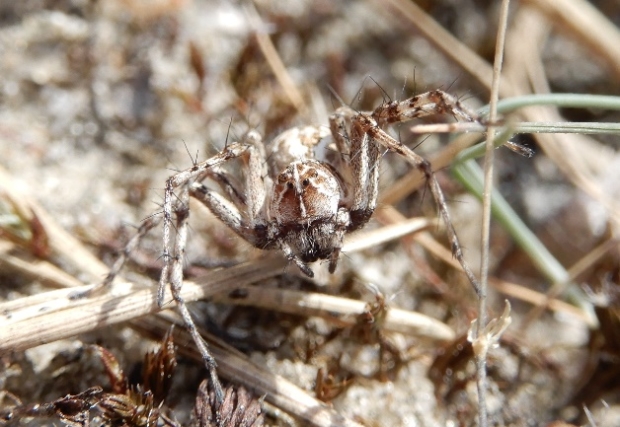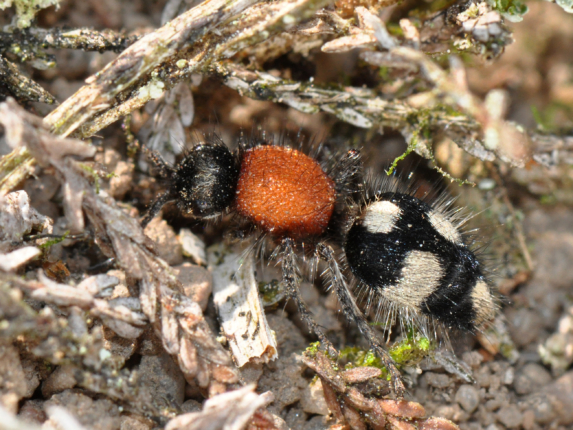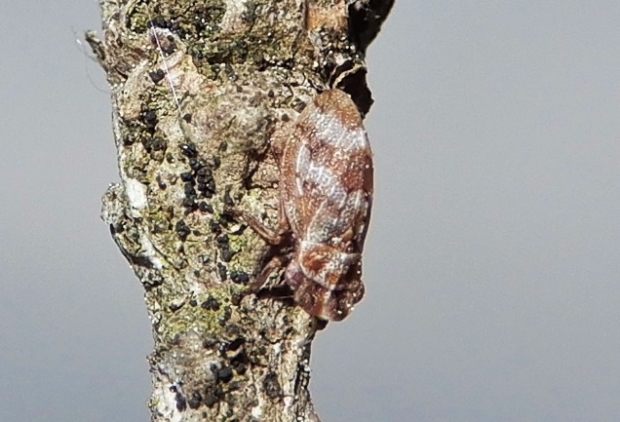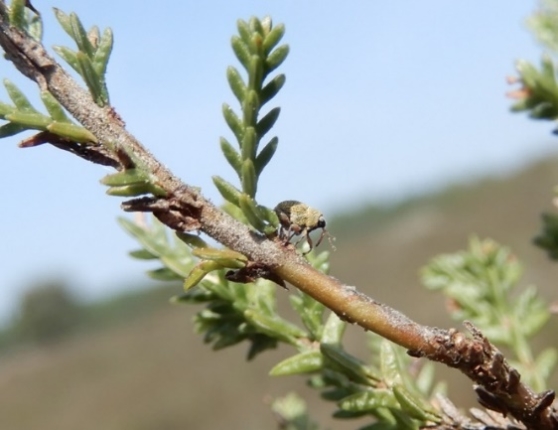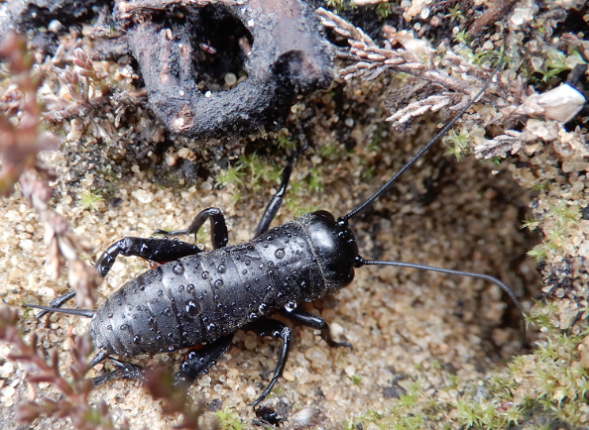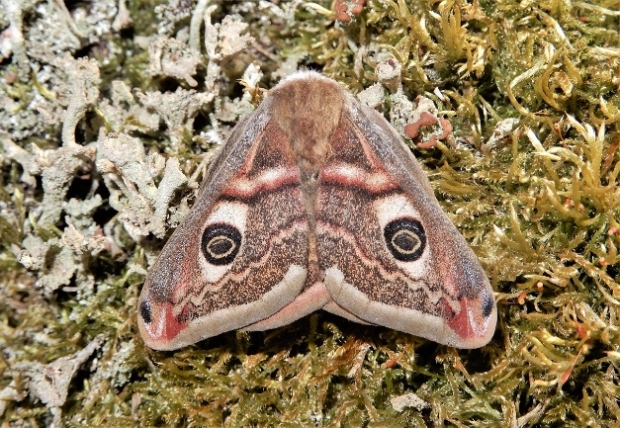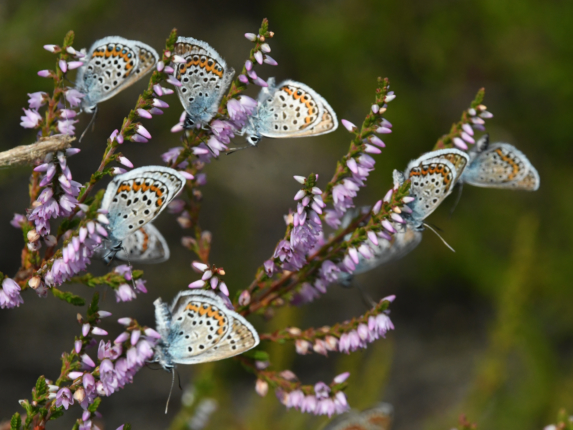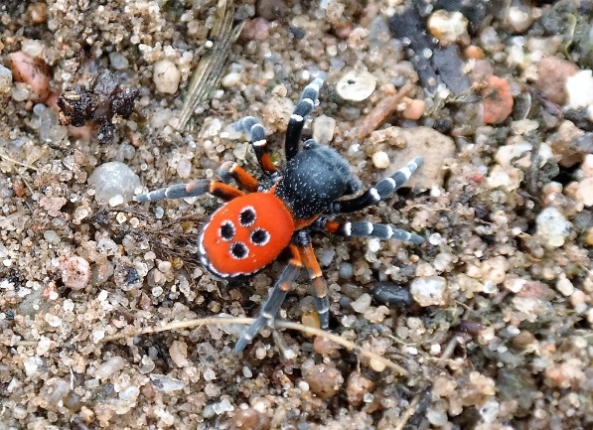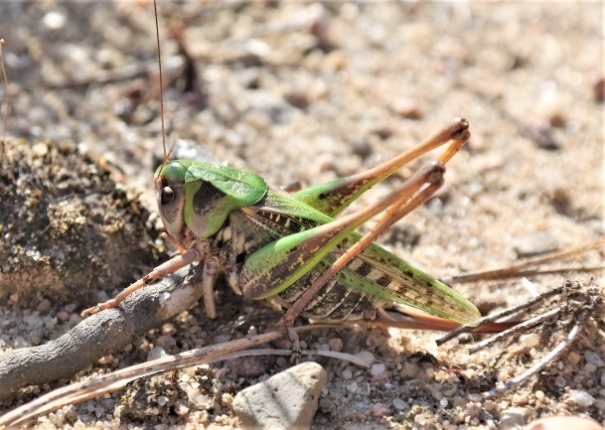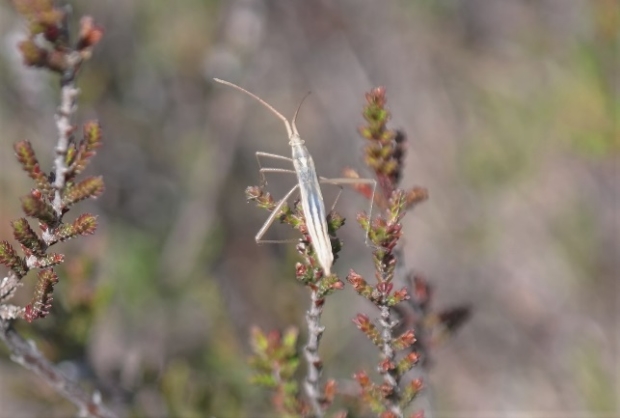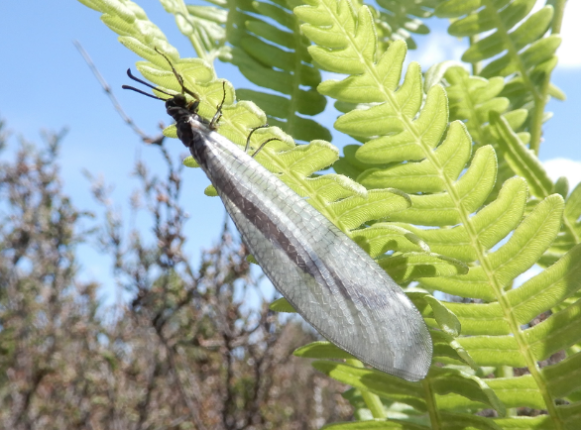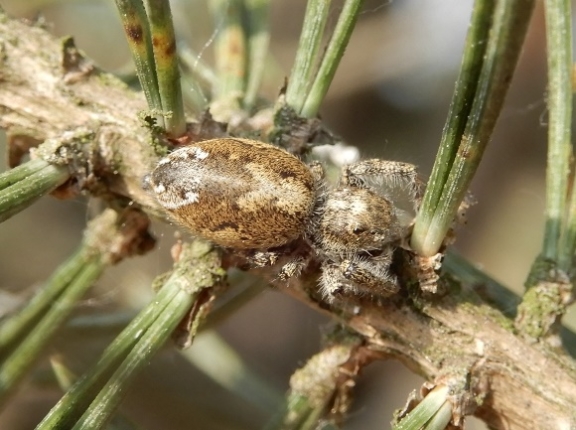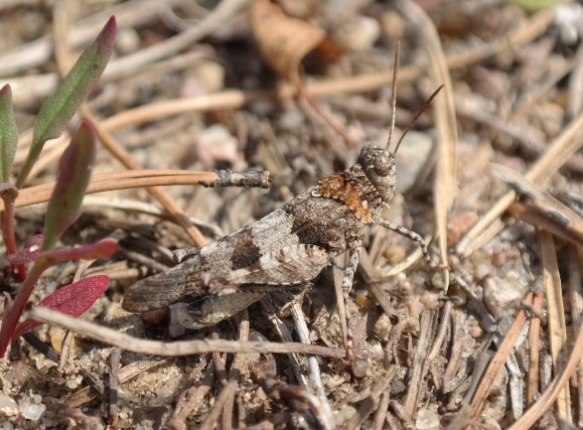

Indicator species
An insight into the biodiversity of the heather landscape
The heather is home to a wide variety of animal species, many of which are found only there. Some of them are particularly characteristic of the conservation status of the landscape and can thus be used as bioindicators.
Golden Eyed Jumping Spider - Philaeus chrysops
Like a jewel in the heather, the male of the golden-eyed jumping spider impresses with shining orange colors. The greater female is a quite unremarkable brown colored. These very rare spiders do not live directly from heather. Of course, as predators, they are dependent on the vegetarian animals who feed on heather and capture them there. Typically, these pretty animals are found in areas where there are small pines with bulging branches. These serve as ladder for the animals to hunt for incoming prey from the elevated seat.
Heather Beetle - Lochmaea suturalis
Heather beetles appear on first warm days in spring. Then you can see them fly around in the heath to find a partner and an appropriate place for oviposition. They find those places in old heather stocks, which have a thick layer of moss. The beetle larvae soon hatch in these dense moss carpets. Hidden deep in it, they are protected from many enemies and feed there upon roots of the heather. In rainy summers, many beetles develop, which then appear massively the following year. On the other hand, particularly dry spring and summer months are unfavorable for oviposition and larval development, so that the heather beetle rarely occurs again after such years.
Lynx Spider - Oxyopes ramosus
Characteristics of the lynx spider are the numerous, very long and pointed spines on the legs and the strikingly tall, narrow, forehead. The spider possesses exceptionally good eyesight thanks to its eight eyes. The animals usually remain above ground in low, herbaceous and shrubby vegetation on warm and open terrain. The species is diurnal and weaves no spider nets. Like a lynx – the prey is sneaked and captured in the jump. Similar to jumping spiders, the lynx spider males have to perform a complicated courtship dance with a vibrating hind body and raised forelegs before the chosen one complies…
Velvet Ant - Dasylabris maura
Howdy! In Texas such animals are known under the name “cow-killer”. Although this term is greatly exaggerated, you should still not irritate these animals, as they can sting very painful. Very suitable for this is an Indian name for an ant wasp species in Peru, which is called “ant that makes you scream”. The strong armament combined with an extremely hard shell allows the species to defend against fortified, stabbing digger wasps, whose breeding caves parasitize the ant wasp. To find these strange hiding places with captured insects, the females walk restlessly through the heathland. If she has found a grave wasp cave, she captures it and puts her egg into it, from which soon hatches a larva, which then takes over the well-fed larva of the grave wasp … Since this ant wasp depends directly on the occurrence of its only 1-3 host species, which in turn are highly specialized on the heath habitat, ants wasps are by these complex basic conditions reliable bioindicators for a functioning heath ecosystem.
Heather Leafhopper - Ulopa reticulata
This tiny cicada, barely 3 mm long, is a very common species in heather stocks. Nevertheless, you hardly get to see them, due to the perfectly on heather stems adapted color. At the Calluna plants the leafhopper sucks the sweet cell juice and hardly moves. Unlike other cicadas, the hind legs are not modified for jumping. Additionally, wings are also missing at most individuals. Only very few females own long wings, are able to fly and can colonize other heather areas. Due to the large number of heather cicadas, they occupy a very important position in the food web of heathland, because a large number of predatory animals live on heather cicadas.
Small Heather Weevil - Micrelus ericae
This little long-snout has a very special appetite: he feds exclusively on young heather leaves. Otherwise, there is nothing in the world that he like. The female beetle lays its eggs in the young flower buds of the heather in whose ovary of the flowers the young larvae develop in the summer. Thus, the species depend on abundant flowering of the heather and its frequent occurrence is a sure indication of vital heather stocks! For their part, the small weevils are the food source for the Heath Damsel Bug, jumping spiders etc.
Field Cricket - Gryllus campestris
Field crickets are typical animals of heathlands. They are particularly characteristic for areas of fire managment. They do not feed mainly on heather, but they appreciate dry and warm climate on open grounds, where hunting is easy and where the availability of prey and fresh green is optimal. As a large insect, they are in turn highly favorable as food for the hoopoe. Since field crickets thus occupy an important role in the ecosystem of the heath, one can infer the existence of the animals on the condition and value of the ecosystem. Therefore, field crickets are suitable bioindicators, whose frequencies can be well estimated by the counting of number of singing males or the typical earthworks.
Small emperor moth - Saturnia pavonia
The Small Emperor moth is an unmistakeable insect of heath due to its fluffy appearance, grey-brown wings with big peacock-like eyespots. These spots are intended to imitate the eyes of predators like cats and, in the case of an attacking bird, frighten this one to use this moment to escape. Its flying season already starts in the first warm April days. Then the males fly around the heath to find their females. After mating, the females then like to lay their eggs on heather, on which the caterpillars feed during the summer.
Silver-studded blue - Plebejus argus
In summer, the silver-studded blue butterflies can be detected on flowers along sandy paths. There they suck flower nectar on the few flowering thyme plants. It often comes to hustle and bustle. The many butterflies have nourished themselves as caterpillars of heather. After the caterpillars had eaten their fill, they lured ants through sweet excrements, which they immediately put into their underground burrows. In the community of ants and under their protection, the caterpillars pupate, to thank the ants continue to receive the sweet secretion. In order to enable this beneficial relationship to the offspring, the females endeavour to lay their eggs near the ant nests.
Ladybird Spider - Eresus kollari
The Ladybird Spider is a great peculiarity of the heath. The males have a bright red abdomen, the females are grey-brown to black. Both sexes are unusually large for spiders. Their food consists mainly of beetles that attack them from their earth tubes. These earth tubes are covered with a felted net and littered with plenty of food leftovers. They are mainly found in heath, where there are always larger gaps with open soil between the heath bushes. The very conspicuous males search in late summer in warm weather for partners. Instead, they crawl around the heath, homeless, until they find the nesting tube of a female. If the female wants to get involved with the male, it allows the male to move into its tube and from then on they share their food. The oviposition takes place then in the tube. After hatching, the young spiders are fed with pre-digested food from the mother’s mouth. Gradually, the internal organs of the spider mother turn into food pulp and after a few days she dies. The cubs are now starting to suck the dead body. Together, the young spiders spend the winter in the maternal web. Only in the spring they move out and build their own nets in the immediate vicinity and thereby form small spider colonies.
Wart-biter crickets - Decticus verrucivorus
Wart-biter crickets are among the largest insects in the heath. They feed on tender parts of small plants but also on other insects such as grasshoppers. Together with the field cricket, this large insect is the basis of a rich insect hunting bird fauna such as hoopoe and great grey shrike. As the name wart-biter might suggest, it is an insect that may be able to help with a skin condition. In fact, these animals were formerly used in folk medicine for biting off warts or thoroughly cleaning wound edges.
Grass Ghost - Chorosoma schillingii
Chorosoma schillingii is a thin vegetarian scentless plant bug. It is hardly visible in the dry tangle of heather and grasses, as long as it does not move, because it resembles a dry stalk in every detail. In this way, best camouflaged, it prefers to suck on grey hair-grass or sheep’s sorrel with its beak-like mouthparts. Oviposition takes place from August and the eggs overwinter. In spring, the young bugs hatch and begin to feed on the fresh green.
Heath tiger beetle - Cicindela sylvatica
Heather tiger beetle can often be seen on the sand paths, fire protection strips and burned heath areas. There, the animals hunt for insects and spiders in a rapid sprint, which they grip with the jaws and then suck. On the one hand, its long legs ensure hunting success, on the other hand they also ensure that the beetle body is lifted as far as possible from the ground. In the hot summer, the beetle escapes the impending heat death on the heated sandy ground. In case of imminent danger, the beetles also show their good airworthiness. In contrast to the adult beetle, its larvae are not mobile at all: they live in self-dug dwellings in the loose sandy soil, which they cannot leave, and hunt from there to passing insects to eat them.
Common antlion - Myrmeleon formicarius
Adult antlions resemble small dragonflies. But during the day they sit on branches or on undersides of leaves, as they are usually only active at night. Then the antlions go on dating. In principle, there is nothing to eat during their adult phase. This ascetic way of life differs greatly from their predatory youth in which they, as juvenile antlions, made the sandy soil ants unsafe. As a trapped lurking hunter, the antlion larva digs a steep funnel into the loose sand and waits at the bottom of the funnel for an insect to slip into the trap. In order to make the escape from the trap more difficult, the antlion also throws sand and tries to pack its slipping-down prey with its sharp, large pine tongs.
Large Jumping Spider - Dendryphantes hastatus
This large jumping spider has a penchant for small pines in the heathland. There it places its silky nest at the branching points of the branches. On such single trees in the heath, the spider profits on the one hand from the dry-warm conditions that it would not find in closed forests. On the other hand, single trees also act like a magnet for many prey as a structural element. So the jumping spider just needs to wait until a suitable meal comes by, which takes it by surprise from the stand in the jump. Her perfect camouflage helps her by perfectly imitating the dry, fine-scaly pine bark with faded whitish resin drops on it.
Blue Band-winged Grasshopper - Oedipoda caerulescens
Approaching a Blue Band-winged Grasshopper so it remains completely motionless and confiding on its perfect camouflage very long sitting on the ground. At the very last moment, however, it still jumps off, presenting its bright blue hind wings. It flies so a few meters further and just before the landing it beats again a hook, so as not to make it easy for its pursuer to track down the animal again. Blue Band-winged Grasshopper are common in many open, sandy areas. Thus, they are also abundantly represented in the heath. There they feed on many small plant species.
images & text by Dr. Carsten Neumann ,Dr. Joerg Mueller, Dr. Hannes Petrischak



